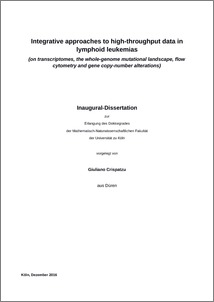Crispatzu, Giuliano
(2017).
Integrative approaches to high-throughput data in lymphoid leukemias (on transcriptomes, the whole-genome mutational landscape, flow cytometry and gene copy-number alterations).
PhD thesis, Universität zu Köln.

![[img]](https://kups.ub.uni-koeln.de/style/images/fileicons/application_pdf.png)  Preview |
|
PDF
Crispatzu2017_with_line_nrs_redact.pdf
- Accepted Version
Download (257MB)
|
Abstract
Within this thesis I developed a new approach for the analysis and integration of heterogeneous leukemic data sets applicable to any high-throughput analysis including basic research. All layers are stored in a semantic graph which facilitates modifications by just adding edges (relationships/attributes) and nodes (values/results) as well as calculating biological consensus and clinical correlation. The front-end is accessible through a GUI (graphical user interface) on a Java-based Semantic Web server. I used this framework to describe the genomic landscape of T-PLL (T-cell prolymphocytic leukemia), which is a rare (~0.6/million) mature T-cell malignancy with aggressive clinical course, notorious treatment resistance, and generally low overall survival. We have conducted gene expression and copy-number profiling as well as NGS (next-generation sequencing) analyses on a cohort comprising 94 T-PLL cases. TCL1A (T-cell leukemia/lymphoma 1A) overexpression and ATM (Ataxia Telangiectasia Mutated) impairment represent central hallmarks of T-PLL, predictive for patient survival, T-cell function and proper DNA damage responses. We identified new chromosomal lesions, including a gain of AGO2 (Argonaute 2, RISC Catalytic Component; 57.14% of cases), which is decisive for the chromosome 8q lesion. While we found significant enrichments of truncating mutations in ATM mut/no del (p=0.01365), as well as FAT (FAT Atypical Cadherin) domain mutations in ATM mut/del (p=0.01156), JAK3 (Janus Kinase 3) mut/ATM del cases may represent another tumor lineage. Using whole-transcriptome sequencing, we identified novel structural variants affecting chromosome 14 that lead to the expression of a TCL1A-TCR (T-cell receptor) fusion transcript and a likely degradated TCL1A protein. Two clustering approaches of normal T-cell subsets vs. leukemia gene expression profiles, as well as immunophenotyping-based agglomerative clustering and TCR repertoire reconstruction further revealed a restricted, memory-like T-cell phenotype. This is to date the most comprehensive, multi-level, integrative study on T-PLL and it led to an evolutionary disease model and a histone deacetylase-inhibiting / double strand break-inducing treatment that performs better than the current standard of chemoimmunotherapy in preclinical testing.
| Item Type: |
Thesis
(PhD thesis)
|
| Translated title: |
| Title | Language |
|---|
| Integrative Ansätze zu Hochdurchsatzdaten in lymphoiden Leukämien | German |
|
| Translated abstract: |
| Abstract | Language |
|---|
| In dieser Dissertation habe ich eine neue Herangehensweise entwickelt, welche die Analyse und Integration von heterogenen Leukämiedatensätzen erleichtert, sowie anwendbar auf eine Vielzahl hochdurchsatzbasierter Grundlagenexperimente ist. Alle Datenschichten werden in einem semantischem Graphen gespeichert, was wiederum Änderungen in Form des Hinzufügens von Kanten (Beziehungen/Attribute) und Knoten (Werte/Resultate) möglich macht, sowie generell das Errechnen von biologischem Konsens und klinischer Korrelationen. Das System ist erreichbar durch eine graphische Benutzeroberfläche auf einem Java-basiertem Semantic Web-Server. Ich nutzte das Rahmenprogramm weiterhin zum Beschreiben der genomischen Landschaft der T-PLL (T-Zell prolymphozytische Leukämie), einer seltenen (~0.6/Millionen) Erkrankung reifer T-Zellen mit aggressivem klinischem Verlauf, notorischer Behandlungsresistenz und generell niedriger Überlebensrate. Wir erstellten Genexpressions- und Kopiernummer-Profile, sowie NGS (next-generation sequencing) innerhalb einer Kohorte von 94 T-PLL Patienten. TCL1A (T-cell leukemia/lymphoma 1A) Überexpression und ATM (Ataxia Telangiectasia Mutated) Beeinträchtigung repräsentieren zentrale Charakteristiken der T-PLL, prädiktiv für das Überleben des Patienten, T-Zell-Funktion und reibungsloses Antworten auf DNA-Schaden. Wir haben neue chromosomale Läsionen identifiziert, einschließlich einer Kopienzahlamplifikation in AGO2 (Argonaute 2, RISC Catalytic Component; 57.14% der Fälle), welches maßgeblich für die Läsion in Chromosom 8q ist. Weil wir signifikante Anreicherungen von trunkierenden ATM Mutationen in ATM mutiert/ohne Deletion (p=0.01365), sowie FAT (FAT Atypical Cadherin)-Domänen-Mutationen in ATM mutiert/deletiert (p=0.01156) fanden, könnte es sich bei JAK3 (Janus Kinase 3) mutierten/ATM deletierten Fällen um Fälle einer separaten Tumor-Enwicklungslaufbahn handeln. Mithilfe von Transkriptom-Sequenzierung identifizierten wir neuartige strukturelle Variationen, die Chromosom 14 beeinflussen und zur Expression eines TCL1A-TCR (T-Zell-Rezeptor) Fusionstranskriptes führen, welches wahrscheinlich in einem degradiertem TCL1A Protein resultiert. Zwei Gruppierungsansätze zwischen den Genexpressions-Profilen von normalen T-Zellen und leukämischen Fällen, sowie Immunophenotypisierungs-basiertem agglomerativen Gruppierungen und der Rekonstruktion des TCR-Repertoire veranschaulichten einen restriktiven, memory-like T-Zell Phenotyp. Dies ist damit die bis dato umfangreichste und integrativste Studie der T-PLL, durch welche ein evolutionäres Krankheitsmodell etabliert werden konnte und eine Histon-Deacetylase-hemmende / Doppelstrangbrüche-induzierende Behandlung, die besser in prä-klinischen Tests abschneidet als der momentane Standard der Chemoimmuntherapie. | German |
|
| Creators: |
| Creators | Email | ORCID | ORCID Put Code |
|---|
| Crispatzu, Giuliano | gcrispat@uni-koeln.de | UNSPECIFIED | UNSPECIFIED |
|
| Corporate Creators: |
Uniklinik Köln, Universität Köln, CECAD |
| URN: |
urn:nbn:de:hbz:38-78024 |
| Date: |
2 January 2017 |
| Language: |
English |
| Faculty: |
Faculty of Mathematics and Natural Sciences |
| Divisions: |
Faculty of Mathematics and Natural Sciences > Department of Biology > Institute for Genetics |
| Subjects: |
Data processing Computer science
Life sciences |
| Uncontrolled Keywords: |
| Keywords | Language |
|---|
| clonal evolution, cancer genomics, t-cells, immunology, semantic web, bioinformatics, computational biology, TCR, NGS | English |
|
| Date of oral exam: |
20 February 2017 |
| Referee: |
| Name | Academic Title |
|---|
| Nothnagel, Michael | Prof. Dr. | | Wollnik, Bernd | Prof. Dr. | | Krug, Joachim | Prof. Dr. | | Thiele, Holger | Dr. |
|
| Refereed: |
Yes |
| URI: |
http://kups.ub.uni-koeln.de/id/eprint/7802 |
Downloads per month over past year
Export
Actions (login required)
 |
View Item |


